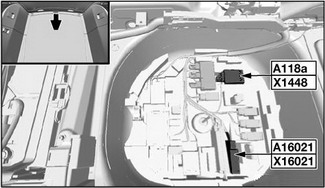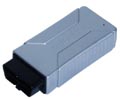- Self-leveling suspension
- |
- BMW Electronic Systems
- |
- Technical Info
- |
- Car Tech Info
- |
- MicroTronik
Self-leveling suspension (EHC)

The self-leveling suspension is a further development of the EHC system as already used on the 5 Series and X5.
Operating principle of the control unit
The control unit processes the following signals and K-CAN messages:
· Ride-level height of vehicle from ride height sensors located at the rear right and rear left.
· Load-cutout signal (of power management battery voltage)
· Terminal 15 ON/OFF (K-CAN message terminal status)
· Vehicle speed (K-CAN message dynamism)
· Transversal acceleration (K-CAN message dynamism)
· Engine-running signal (K-CAN message driver display, engine)
· Information on the flap status (K-CAN message flap status)
The control unit decides case by case whether there is a need for intervention to balance out changes in load.
It prevents intervention in the case of other causes. This makes it possible to gear the intervention to each situation as regards optimum frequency, target height, tolerance thresholds and battery load.
In addition to handling the self-leveling suspension, the control unit has the task of monitoring the system components, saving and displaying faults.
The task of the self-leveling suspension is to bring the vehicle ride height at the rear axle back to the target level if the load changes. The self-leveling suspension works by feeding or extracting air into or out of the bellows. The height sensors provide the control unit with information on the heights of the left-hand and right hand sides of the vehicle. If the heights are outside the specified tolerances, the system intervenes using the air supply unit to set the nominal ride-level height.
Changes to the load mainly take place when the vehicle is at a standstill, before or after a journey. In order to load the vehicle, the doors or boot/rear hatch have to be opened. The system is therefore enabled when a door or the boot/rear hatch is opened and only switches itself off 16 minutes after the vehicle has been vacated (load-cutout signal).
In order to distinguish load changes from other disturbances such as road irregularities, the height signals are filtered through two different low pass filters with different limit frequencies (high and low frequencies). The filtering is explained in the HGK E39 drive/suspension. Various signals and messages indicate the different driving conditions to the control unit, which switches into various operating modes depending on the condition.
Intervention modes
The operating modes intervene depending on the vehicle condition or suppress interventions. Intervention modes are:
· Sleep
· Pre (pre-/after-run)
· Post (post adjustment)
· Normal (engine running)
· Drive
· Curve (driving in a curve)
· Kerb
· Lift (workshop platform)
· Transport
· Assembly Line Mode
Sleep
The Sleep mode is the initial state for interventions. In the Sleep mode, no intervention takes place.
Pre (pre-/after-run)
In the Pre mode, the load-cutout message of the power module initiates a time- controlled pre-run and after-run. The load-cutout signal is set by activities on the vehicle such as pressing the door handle or operating the central locking system and output on the K-CAN.
In the case of ignition key position terminal R or terminal 15 or engine on signal, the signal is set permanently.
If the vehicle is parked, the load-cutout signal remains set for approx. 16 minutes after the last action (like door opening). If a door status changes within these 16 minutes, the after-run time is restarted. When this after run time expires, the message (switch off consumers) is sent and the control unit switches for 1 minute into the Post mode before it goes into the Sleep mode.
In the Pre mode, the vehicle can only be raised to its specified height if the level drops significantly below the specified height. The intervention tolerance range is 40 mm from the mean value. This intervention tolerance ensures that the vehicle is only raised for heavier loads to increase ground clearance before driving off. Smaller payloads only lead to small amounts of spring travel which are only balanced out after the engine has been started. This setting reduces the load on the battery.
The vehicle is lowered when the mean value of the two height signals greater than 0 mm AND one side is above 10 mm.
For the decision regarding intervention in this mode, only the mean value of the two height signals (fast filter) is analyzed.
Interventions that were started in other modes are continued with the internal tolerance ranges that apply to these modes.
There is no inclination detection in the Pre mode.
On return to the normal mode from the Drive mode, intervention remains blocked until a door is operated. This prevents intervention when the vehicle is at traffic lights, for example, and the pitching motion at the rear axle causes the height to rise above the mean value.
Post
The Post mode is used to balance out any visual inclination before entering the Sleep mode. It is a mode for post-adjustment. The Post mode is limited regarding time (currently coded for 1 minute). The Post mode is only run when the engine has been running. Without previous engine operation, a direct switch is made from the Pre mode to the Sleep mode.
Intervention takes place within a narrow tolerance range of 7 mm. At 5 mm, the intervention is stopped. The fast signal filter is used. In the case of an inclination (kerb detection), intervention is at the specified heights applicable to this case.
Normal
The Normal mode is the starting point for the normal operating status of the vehicle. It is reached by means of the (engine running) signal.
The fast filter is used with a narrow tolerance range of 10 mm. A narrower tolerance range than in the Pre mode can be used because the battery capacity does not have to be protected.
In the case of a vehicle inclination (kerb detection), intervention is at the specified heights applicable to this case.
Drive
The Drive mode is activated when a speed signal of more than 1 km/h is detected. The intervention is activated by a slow filtering if the signals, as in this operating mode only the height differences caused by the negative force of the vehicle and reduction of the vehicle mass due to fuel consumption have to be balanced out. The intervention itself, however, takes account of the fast filtered heights. For the end of control/intervention, the slow filters are reinitialized.
Curve
As rolling motion has a direct influence on the measured heights, longer driving in a curve with a corresponding roll angle would lead to undesired intervention in spite of the slow filtering of the Drive mode.
On completion of the curve, this would lead to an inclination and renewed intervention. The Curve mode prevents this intervention in that the slow filtering is halted when driving in a curve is detected and any intervention that might have been started is cancelled.
Driving in a curve is detected in the case of an incoming transverse acceleration signal greater than 2 m/s2. With a transverse acceleration signal less than 1.5 m/s2, the Curve mode is closed.
The transverse acceleration signal is sent by the yaw rate sensor.
Kerb
Kerb Detecting this state prevents the inclination produced when one side of the vehicle rises on an obstacle with one wheel from being balanced out. Compensation would, after driving off the obstacle, lead to a renewed inclination of the vehicle and a renewed intervention.
The Kerb state is detected when the difference in height between the left-hand and right-hand sides of the vehicle more than 24 mm.
If the vehicle is loaded or unloaded on an inclination, the control unit analyses the value of the middle of the car between the rear wheels. The value is calculated in the control unit from the changes in height of the right hand and left-hand spring paths.
If the value of the spring travel or rebound at the calculated centre of the rear axle lies outside the tolerance range of 10 mm, self-leveling is triggered. The left-hand and right-hand sides of the vehicle are raised or lowered in parallel. The difference in height between the two sides remains. As soon as the control unit goes into Drive mode, the Inclination mode is deleted.
Lift
In order to prevent intervention in the case of a wheel change or work on the workshop platform, there is the Lift mode.
If this mode is detected, all interventions are prevented until the car jack is removed or the vehicle is lowered from the workshop platform.
Detection takes place when the permitted rebound path of 55 mm is exceeded. If the left-hand and/or right hand height exceeds this rebound path, the situation wheel change/workshop platform is detected.
The workshop platform situation is also detected if the vehicle is raised slightly, the rebound path of 55 mm has not yet been reached, the vehicle wants to intervene, but does not lower. If the drain valve is activated and the vehicle does not lower, the workshop platform situation is detected after a certain time and this height is saved. A reset is carried out if the vehicle is again 10 mm under this stored height or Drive is detected.
Transport mode
The Transport mode is set by means of diagnosis activation. It serves to increase the ground clearance to ensure safe transport of vehicles on transporters. The specified height of the vehicle is raised by 30 mm in this mode.
When this mode is activated, the symbol for the air suspension function is displayed in the instrument cluster in the variable indicator light and the text message (Self-leveling suspension failure) is output in the Check Control display to indicate this special mode.
There is no intervention in this mode, as there are no changes to the vehicle mass during transport.
The Transport mode is deleted only by means of diagnosis activation.
Assembly Line Mode
The Assembly Line mode is set for the assembly line to prevent regulating operations. The fault display is activated and shown in the variable indicator light by a symbol and in the Check Control display with the text message (Self-leveling suspension failure).
The Assembly Line mode is deleted only by means of diagnosis activation.
is one of the best Professional scan tools to for BMW; Autohex allows you to diagnose, code, program/flash ecus, replace with used ECUs, and add new keys for BMW. For more information: BMW Scan Tool
Changing Dmaged DME in F Series


